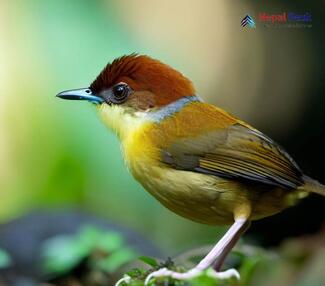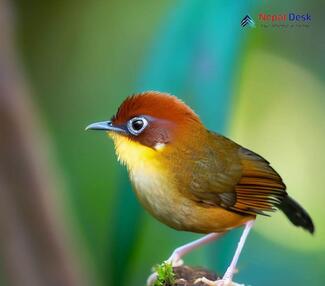Nestled within the heart of the Himalayas, Nepal is brimming with biodiversity, home to a wide array of plants and animals. Among its hidden gems is a captivating little songbird called the Chestnut-headed Tesia (Cettia castaneocoronata). This small insect-eating bird, once classified as part of the "Old World warbler" family, now belongs to the bush warbler family (Cettiidae). First described by English army officer and zoologist Edward Burton in 1836 as Sylvia castaneocoronata, its specific epithet blends the Latin words "castaneus" (chestnut-colored) and "coronatus" (crowned). Formerly placed in the genus Tesia, a 2011 molecular phylogenetic study revealed that the Chestnut-headed Tesia was part of a group containing members of the genus Cettia. Now that we've discovered more about this enchanting bird, let's explore further its fascinating world within Nepal's lush forests.
Physical Features and Living Environment
The Chestnut-headed Tesia is a petite passerine bird, ranging from 9 to 11 centimeters in length. It boasts a unique appearance with its chestnut-colored head, vivid olive-green back, and pale underside. Additionally, this charming bird has striking white eyebrows that stand out against its dark eye stripe, making it easily recognizable for avid birdwatchers.
This captivating species favors thick undergrowth in subtropical or tropical moist montane forests as its ideal living environment. First discovered in Nepal, the Chestnut-headed Tesia can also be found across different parts of Asia including the Indian subcontinent, Bhutan, northeastern India, Vietnam, Bangladesh, Laos, Myanmar, and Thailand.
Eating Habits and Social Behavior
Primarily feeding on insects and small invertebrates, Chestnut-headed Tiesias forage through leaves and vines using their sharp beaks to find caterpillars, ants, beetles, flies, and spiders. If insects prove to be scarce, they may also eat fruit or seeds.
These birds are known to be solitary creatures that prefer skulking around quietly under dense foliage rather than being out in the open. Due to their small stature and elusive nature, they can be quite difficult to spot. They communicate with other birds using an array of high-pitched melodic notes.
Conservation Status
The International Union for Conservation of Nature (IUCN) has categorized the Chestnut-headed Tesia as a species of "Least Concern" owing to its ample population and wide distribution. Nevertheless, it's crucial not to become complacent, as habitat loss and deforestation could pose potential threats to their survival in the future.
Final Thoughts
The Chestnut-headed Tesia contributes significantly to the biodiversity in Nepal and neighboring regions. With its intriguing characteristics and enchanting appearance, this little bird is sure to capture the hearts of bird enthusiasts and nature lovers. By expanding our knowledge of these unique birds, we can appreciate the remarkable variety of avian life existing in this part of the world and be inspired to protect their habitats for future generations to enjoy.




